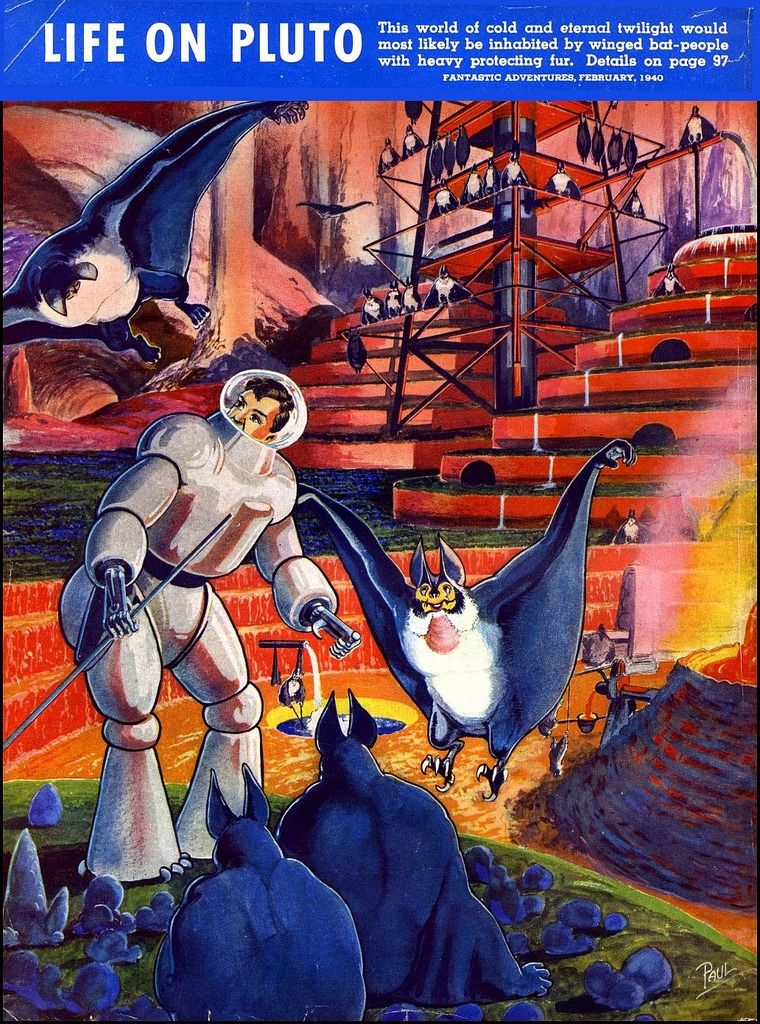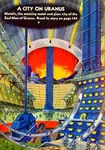what to see on
pluto
For a scenic browse, and an answer-page for Guess The World...

sniff the air on pluto
...In that first confused glimpse, my eyes did not take in the details of the landscape. Stretching out before me was a broken plain, fantastic and irregular at the floor of a glacier; huge bluish white masses, piled and tumbled together in crazy disorder, were varied by smooth glistening spaces as flat as a table; twenty-foot mounds and hummocks stood up here and there, and long twisted furrows or cracks spread a spidery black network across the scene; while the prevailing hue, in the wintry gray light of the far, far glittering point of a sun, was that eerie, spectral mixture of blue and white, reminding me of the cloud-filtered moonlight peeping down upon a lake of ice.
But all this I was to notice subsequently; in the first bewildered moment of my escape, there was only one thought to dominate my mind. I must free myself from the gas-mask, whose weight burdened my shoulders, whose confinement had nearly asphyxiated me! I must unbare my nostrils to the open winds, must drink a reviving draught of actual air! True, this alien atmosphere might be poison to my lungs; true, the cold might freeze the very blood within my veins – yet I must take the risk; indeed, I was frantic to take the risk, and clutched at the fastenings of my mask with blind desperation. And within a few minutes, though at first my nervous fingers would not gain any hold, I saw the mask yielding, and felt the burning chill of the outer air against my cheeks.
Colder than ice, the air was yet less cold than I had anticipated. It did not freeze my flesh, nor did it strike my lungs like a blast of poison; rather it was the most delicious, life-giving breath I ever drew. It seemed to me that the atmosphere was lighter than on earth – light as on some high mountain peak; but it required no chemical analysis to show that it contained oxygen!...
Stanton A Coblenz, Into Plutonian Depths (Wonder Stories Quarterly, Spring 1931)
carnivorous crystals of pluto
...She seized his arm, dragging him back. "They're carbon feeders! Don't you understand? They're carbon feeders! Your body has carbon. They're - look out!"
Keene started back, realizing that a gray-black, flat-crystalled, dully shining lump was almost at his feet. He stared at the crawling masses; they had come, apparently, from beyond a jutting wall of rock to his right. The floor was speckled everywhere with them, and now and again one slipped with a faint tinkle over the edge of the central pit. But there were hundreds more; one couldn't wait here until the floor had cleared. He skipped aside; another had silently approached almost to his feet.
He acted...
Stanley G Weinbaum, The Red Peri (Astounding, November 1935)
the marching mountains of pluto
...he stood petrified for a moment on the rough ice, staring northeastward. He and his companions looked frozenly up at an awful peril thundering down on them.
The Marching Mountains! The vast thousand-foot high range of icy hills that was but one of similar glacier-ranges which perpetually moved around the planet!
The forefront of the appalling walking ice-range was a towering, gleaming cliff that was only a few hundred yards from them. And the whole cliff was advancing on them, moving at an incredible speed of many yards a minute, pushed forward by the vast glacial masses of ice behind it. From the icy moving cliff fell great bergs and masses of ice, over which the main range moved crushingly as it came on.
"Out of here!" Captain Future yelled. "We'll have to run for it - this way!"
"There
is no use running from the Marching Mountains," cried Tharb
hopelessly. "We cannot get out of their path and they will soon
overtake us."
Edmond Hamilton, Captain Future's Challenge (1940)
deadly music on pluto
A level space, nearly circular, a mile wide. Surrounded with a curving ridge, it was scattered with heaps of crumbled stone. The piles, Ellis thought, were too regular to be anything save remains of buildings, but buildings that had been ruins five hundred thousand years, or a million. Where had the survivors gone - if there had been survivors?
The question was answered without words.
The silent music swept them on... across the dead mounds, towards the cyanic-shining, vertical wall of the pit. It carried them out of the ruins, upon a worn and ancient road. And the road sloped downward, curved into a vast crevice whose jagged walls glowed with light of sapphires.
From the crevice they passed into lofty and interminable vaulted caverns, whose smoothed walls yet bore the mark of tools. Dust of eons lay thick upon the floor, swirled up chokingly about them.
The compelling, noiseless chords led them downward once more, and into a lower system of artificial caverns. Here the rock was brighter still, glowing with radiance softly electric-blue, shadowless and unearthly. The air was heavier here, and warmer, and the floor was clear of dust.
They
were drawn into a colossal space, blue-walled, domed and circular, and
far out across its floor. The mad music abruptly ceased its throbbing
in their brains. The journey was ended.
Jack Williamson, The Plutonian Terror (Weird Tales, October 1933)
a monster in the sea of avernus on pluto
The robot's metal hand pointed toward a ripple that was approaching them through the moonlit water - a ripple that was ominously deliberate and steady in its advance.
"It's a bibur - one of the greatest and most terrible sea-monsters of our world!" yelled Tharb. "Paddle away!"
But their attempt at retreat was too slow to be of any avail. That rippling came closer, and they could clearly see it was caused by an enormous body swimming beneath the surface.
Then
out of the moonlit sea a huge living thing broke surface. It was of
brontosaurus bulk, its immense, sleek, wet, furry body urged forward by
webbed paws, its snaky neck ending in a snarling head of great fangs and
blazing red eyes...
Edmond Hamilton, Captain Future's Challenge (1940)
Plutonians detect a visitor
…Their heads were roughly triangular, widening upward from a pointed chin and resting on thin, yet strong, necks above equally strong and spindly man-like bodies. They were mainly composed of elements which became solid only at very low temperatures.
Thus it was that one of these beings sat before a radio-like device and perspired in the extreme cold of the room. His long pointed ears were depressed by the weight of a shiny metal cap and his too-large eyes held a look of worried consternation…
The wearer of the cap shot a series of rapid sounds at the other occupant of the room.
He said, in effect, “I have received thought-emanations from the direction of the great plain, rather garbled. The being is probably a giant from some other world, for his thoughts are alien and he evidently considers it within his power to crush the mountains which house us!”
The other made a negative gesture with a slender hand. “Don’t you think it more likely that it is a trick of the enemy, Gor? They have tried such things before, you know.”
Gor was quiet while he peered into the eyepiece of an instrument; then he replied, “We will soon know… You are radiating sorrow, Bakar. What troubles you?”
Bakar sighed. “I was thinking of the ancient pictures of Ahndee in the days when its orbit was much nearer the Sun, and we, the inhabitants of Ahndee, were happy in our beautiful cities.
“Now, the two remaining great nations hide, one from the other, beneath the mountains, and neither can break the defenses of the other, but we still try. What is the use of it?”
“Careful, Bakar,” Gor looked sternly at the other. “The Four may have you in the thought beam…”
William Oberfield, Escape from Pluto (Planet Stories, Fall 1947)
industrial base on pluto
…There was a base there for the heavily-shielded R-40’s that carried the uranium ore from the mines. Behind it there were black mountains sheathed in ice, and all around it was a plain that glittered in the starlight, white with frozen air. The base itself was one vast sunken dome, for the ships and for the men that served them. But to one side was a second dome, and above it was a group of towers somewhat different from those of the base proper, squatter and more massive. This place had been used once. Since then it had lain quiet, its contents sheathed coccoon-like in protective webs.
Now men invaded it again, stripping away the sheathing, checking, testing, making delicate adjustments. And underneath the dome the glass dynamos awoke, and the solid granite of the plain was shaken…
Leigh Brackett, The Ark of Mars (Planet Stories, September 1953)
life in pluto's fluorine ocean
…She stopped suddenly, and cold, clammy fingers of fear rippled along her spine. The dark shadow before her… was something tall and thin. Something that seemed alive, weaving back and forth… It seemed about ten feet high and six inches through, and was made up of sections like a string of sausages. Then over to the right she saw more of them – a regular forest.
Like the snapping of a brittle icicle, the tension broke. They were plants. Some form of natural flora, swaying to and fro in the icy currents of that dark sea…
Fletcher Pratt and Lawrence Manning, Expedition to Pluto (Planet Stories, Winter 1939)
a buried giant on pluto
The formation was an almost transparent wall of ice, lying at one end of a small frozen canyon. The snow filtered down from the constantly dark purplish sky, and even though the heating unit in his suit buzzed faintly, generating warmth, Strickland felt a cold wave pass down his back. He shined his torch at the wall and peered through the snow, vague expectation filling him. Far back, behind perhaps ten feet of ice, he could see the outline of a figure, vaguely human.
Milgrim? he wondered. Clyde Starr Milgrim, the first explorer beyond Venus in the early days of the tin ships and the rickety chemical drives…?
Now, nearly a century later, the Milgrim Scientific Foundation had raised enough money to send out search parties in an attempt to find some remains of the man or his ship and carry them home to Earth for fitting burial. Strickland felt a peculiarly acute kinship with the cause. His grandfather had ridden Milgrim’s first ship, The Black Star, out into the uncharted darkness beyond Venus.
But it could not be Milgrim locked within the ice, Strickland reasoned. The figure outlined in frozen patterns of blue shadows was huge and grotesque and misshapen, nearly a dozen feet tall with a head that appeared bulbous and lopsided. Strickland could not make out the face…
John Jakes, Frozen Hell (Planet Stories, July 1952)
blood-drainers of pluto
“We are passing now the fungoid plantations where the agricultural cyborgs are welded to their machines, similar to the pilot. It is a pity you can’t see them now, but you can trust my word, and I’ll happily show you some illustrations when we get to the Capital; we are proud here on Pluto of our mechanistic efficiency.”
“I’m eager to see.”
Diego dozed; time-dilation caused the worst sort of jet lag. He awoke as the doors opened, and he looked outside in the frigid air. Craggy mountains, red and white; the odd fungoid masses further out and what appeared to be agricultural workers, on stilts and augmented bone structures, loading the seashell-shaped masses into the open gondolas of freight cars. The skyscrapers, the same colors as the mountains, blood red and snow white, but without a single window, reaching upwards into the sky.
“That’s enough looking around, professor, you’ll catch a cold with your warm, human blood,” scolded Captain Draque. “Let’s go to the library where you can learn all about Pluto.”
“Hmm, okay; I always prefer to form my own impressions first and then do book research,” mumbled Diego.
“That is ill-advised here,” said Captain Draque sympathetically, “I understand you have your scientific method you so treasure, but we too here have our… political realities, and it is safer for you to read the material that we have prepared for you.”
“Ah… of course,” replied Diego, a chill running down his spine. They entered into a smaller windowless trolley, which was crowded with pale Plutonian bodies, all of them hairless and with beady wide-spaced small black eyes…
Violet Bertelsen, On the Shoreline of Darkness (Vintage Worlds 3, ed. J M Greer and Zendexor, 2020)
>> Guess The World - Third Series
exile on pluto
Walking aimlessly, Rusty left the deserted clearing, plodded up a sparkling path. He wandered amid the ghastly spangled crags, neither knowing nor caring where he went. It did not matter and nothing mattered, for he was dead inside. The three moons of Pluto hung low in the east and the enormous Great Moon, the nearby satellite of the planet, arose beside their departing light, a darker green.
Soon, another day. The cold wind. The Bugs. Haunted, restless sleep. The scream of a lonely soul in dreaming delirium. But what matter the cold and the Bugs? They could bring death. Was it not better so?
Rusty came to a long declivity, the rocks sloping down to a wide crater. In the center was a pale wall of lichen, smoothly white on the side of a towering peak. It was White Cliff. Largest landmark on the narrow-horizoned planet, it reared for hundreds of feet into the thin air. Upon its vast sides was a thick blanket of the plants, giving the cliff an unbroken, white distinctiveness and its name. Never visited by day because of the Bugs, it was rarely approached even at night. The reflecting vegetation surrounding it in a dim glow, the Bugs lingered even then. Foot-long obscenities of fuzzy yellow, razor-tipped tendrils before formless maws, by day they swarmed from every crevice of the distorted terrain. Subsisting chiefly upon the rabbit-like veedles, they would also eat a man.
Carl Selwyn, Exiles of the Three Red Moons (Planet Stories, Summer 1940)
>> Guess The World - Third Series
interstellar meteors rain upon pluto
It seemed to Salvor-Jones that he had been up there forever, with one leg draped over a brace, clumsily working with his heavy gloves. The cold was seeping in more and more in spite of the fact that it could not have been more than half an hour from the time of his ascent.
He clambered down at last, beating his hands together to restore circulation.
Knucklebone Smith, who had done nothing, leaned against the tower on the storm side. He was staring fixedly at something out in that perpetual night. But there was nothing to see. Only the faint glow of the bluish-white methane crystals, swirling through the frozen gullies of the rugged terrain; sweeping around the dark ridges as they were agitated by the driving interstellar dust.
“You’ll be killed out there,” Salvor-Jones said into his mike. “Get behind something, quick!”
Smith said nothing. He just stood there, with his back to Salvor-Jones, contemplating the horizon as the storm rippled his uniform…
Charles A Stearns, The Pluto Lamp (Planet Stories, Fall 1954)
>> Guess The World - Third Series
encounter on pluto
…no three-dimensional creature has ever seen or ever will see in entirety any member of any of the frigid-blooded, poison-breathing races… Of necessity, even in the lowest forms, it possesses an extension into the hyper-dimension; and it is this metabolic extension alone which makes it possible for life to exist under such extreme conditions…
…He could not tell whether it had eyes or antennae; legs, arms, or tentacles, teeth or beaks, talons or claws or feet; skin, scales or feathers. It did not even remotely resemble anything that the Lensman had ever seen, sensed, or imagined. He gave up; sent an exploring thought.
“I am Virgil Samms, a Tellurian,” he sent out slowly, carefully, after he had made contact with the outer fringes of the creature’s mind. “Is it possible for you, sir or madam, to give me a moment of your time?”
“Eminently possible, Lensman Samms, since my time is of completely negligible value.” The monster’s mind flashed into accord with Samms’ with a speed and precision that made him gasp… “’Madam’” might be approximately correct,” the native’s thought went smoothly on. “My name, in your symbology, is Twelfth Pilinipsi; by education, training, and occupation I am a Chief Dexitropober. I perceive that you are indeed a native of that hellish Planet Three, upon which it was assumed for so long that no life could possibly exist. But communication with your race has been almost impossible heretofore… Ah, the Lens. A remarkable device, truly. I would slay you and take it, except for the obvious fact that only you can possess it.”
E E "Doc" Smith, First Lensman (1950)
>> Guess The World - Third Series
a military station on pluto
The military ran Pluto Station, manned it, supplied it, armed it, and used it as a base for keeping watch for mythical intruders who might come wandering into the system from the far-off seas of space. There was not a scientist in the station who did not feel deep in his bones that the military could be dispensed with, that they wasted much money and time keeping watch for non-existent pirates from the depths of space. But the military insisted that this watch was important. Sure, there was peace now, but there might not always be peace. Who knew what monsters might come in from the sea that had no other shore? If space was infinite, the danger might be infinite also. So argued the military. Earth Government backed them up to the extent of manning its planet station with armed forces. On Mars and Venus, they were needed. But here on Pluto what was needed was a way to keep from freezing.
…Pluto Station itself was set in the middle of a vast valley, with low hills surrounding it. On the left, were frozen runways extending the length of the valley. They ended in the vast hump of the huge dome that served as a hangar for the space ships landing on Pluto. The hangar itself was part of the cluster of buildings that made up the station.
Up above the rocky surface of Pluto, slanting down toward the runways, was a pale blue glow…
Stanley Mullen, Cosmic Castaway (Planet Stories, May 1953)
>> Guess The World - Fourth Series
a listening outpost on pluto
Trail’s End, Pluto’s single community, cowering at the foot of a towering black mountain, seemed deserted. There was no stir of life about the buildings that huddled between the spacefield and the mountain. The spiralling tower of the radio station climbed dizzily spaceward and beside it squatted the tiny radio shack. Behind it stood the fueling station and the hangar, while half a mile away loomed the larger building that housed the laboratories of the Solar Science commission.
Caroline moved closer to Gary.
“It seems so lonely,” she whispered. “I don’t like loneliness now… after…”
Gary stirred uneasily, scraping the heavy boots of his spacesuit over the pitted rock. “It’s always lonely enough,” he said. “I wonder where they are.”
Clifford D Simak, Cosmic Engineers (1939, 1950)
>> Guess The World - Fourth Series
a ship from deep space glides down to pluto
They used the elevator to the top of the big building. A lieutenant, his face serious, was waiting for them at the landing. He led them into the top dome.
Above them, through the plastic cover, a million stars sparkled. Seen through airless space, the stars were so brilliant they seemed to be just outside the dome. Pluto Station itself was set in the middle of a vast valley, with low hills surrounding it. On the left, were frozen runways extending the length of the valley. Then ended in the vast hump of the huge dome that served as a hangar for the space ships landing on Pluto. The hangar itself was part of the cluster of buildings that made up the station.
Up above the rocky surface of Pluto, slanting downward toward the runways, was a pale blue glow.
"Hell, that’s not a meteor!” Craig gasped. "That’s a ship coming in from deep space for a landing here.”
Robert Moore Williams, What Inhabits Me? (Planet Stories, March 1953)
>> Guess The World - Fifth Series
evidence of ancient life on pluto
A thin layer of cosmic dust lay over the surface, such as would be found on any airless world. Russ scooped beneath it and came up with a hard chip.
He squeezed it between his gauntleted fingers. It cracked and broke into powder. He whistled softly. “You know what this feels and looks like,” he said as they came close to the frozen creek on the little hillside. “It feels like dirt – common, Earthly dirt. Like soil. And you know what… I can already tell you one of Pluto’s secrets.”
They stopped at the creek. It was a layer of frozen crystalline gases. Haines pushed the alpenstock he was carrying into it and scraped away the gas crystals. “I think I can guess,” he said, “and I’ll bet there is ice under this gas.”
“Pluto was once a warm world with a thick atmosphere,” said Russ. “Notice the rounded hills and the worn away peaks of the mountains. Those are old mountains – weather-beaten. This hill is round – weather-beaten. This creek, those rivers of frozen gas – they follow beds that could only be made by real rivers of warm water. The soil that lies beneath this dust – it could only happen on a world that knew night and day, warmth and light, and rain and wind. Pluto was once a living world…”
Donald A Wollheim, The Secret of the Ninth Planet (1959)
>> Guess The World - Fifth Series
pseudo-alive crystals and crablike crawlers on pluto
Where the Avalon Trail bends across Annihilation Range, a thousand icy miles from Pluto's northern stem, Nolan stopped and closed the intake valve of his helmet. Count five seconds, and he unhooked the exhausted tank of oxygen; count ten more and it was spinning away, end over end over Pluto's frozen surface, and a new tank was already in place. He slipped the pressure valve and inhaled deeply of the new air.
He'd come ten miles by the phosphorescent figures on the nightstone markers beside the trail. Fifteen more miles to go.
His cold black eyes stared absently at the east, where the pseudo-life of the great Plutonian crystals rolled in a shifting, tinkling sea. He noted the water-avid crystals, and noted the three crablike crawlers that munched a solitary clump of metallic grass. You don't walk, talk and breathe after a Tri-planet Lawman has declared you dead unless you note everything around you and react to what may be dangerous.
But he was looking beyond the familiar [Plutonian] drear, to the eastern horizon where faint lights gleamed in the dark. That was Port Avalon. That was where Steve Nolan was bound.
(...)
Then he slammed the inner door, sealed his helmet, pushed his way out.
The crawler was even bigger than he'd thought. Standing within ten feet of it, he felt tiny and weak, a toy before this massive brute. Like ancient Earth dinosaurs, the crawlers kept growing as long as they lived. Tiny as the palm of a man's hand, foot-high creatures like those Nolan had kicked out of his way an hour before or monstrosities like the one before him—all three types existed side by side. Only seldom did they grow as great as this. Invulnerable though they were, they perished of starvation, when their bulk grew too much for their thousands of tiny legs to carry.
Out of the ebon hulk of the thing came poking a minute head, goggle-eyed, with a luminous halo of green tendrils surrounding it. It blinked weakly at Nolan. He waited patiently. If the thing was convinced he was harmless.
It was. Recovering from the shock of the skid's arrival it began to prepare for motion again. The head poked out toward the skid on a long, scrawny neck, examined it minutely. The big carapace shivered and rose slightly off the ground as the multitude of tiny legs took up the task of carrying it forward.
Nolan stood motionless. The creature moved ponderously toward him, ignoring him. In the dull mind of the creature an object as tiny as a man was nothing. Even the skid was merely another sort of boulder, against which it could lean, send it hurtling over to destruction, out of its way.
It moved forward till the hard horn almost touched him. Then Nolan leaped.
This was the moment of decision. He circled the long neck with one lashing arm, clamped on it all the pressure he could bring to bear. It was the one sensitive spot the creature had—and protected, normally, by armor battleship-thick.
Nolan strained the muscles of his arm, cursing the cushion of air inside his suit that made a pillow for the beast. The slippery flesh coiled and writhed in his grip; the beast exhaled a great, whistling screech of agony and the snakelike neck curved around. The popeyed head darted in at him, tiny mouth distended to show raw, red flesh inside. It battered ineffectually against the heavy plastic faceplate of his suit.
The crawler vented its whistling sigh again and staggered drunkenly away. Away from the remorseless pressure on its sore spot, away from the agonizing weight of him. Its tiny legs carried it rocking sidewise.
Then abruptly they tried to halt it, gave sharp warning to the tiny brain. It was too late.
The scrambling legs flailed for a foothold and found vacuum. Nolan gave a final heave, felt the thing slide away from him, leaped back. Just in time. He himself was teetering on the brink of the chasm as the crawler, tiny head darting frantically, soundlessly around, slid over and disappeared.
He didn't look down. The clattering and crashing vibrations from below told what happened. He turned, shook himself and headed for the skid...
Dirk Wylie, Highwayman of the Void (Planet Stories, Fall 1944)
>> Guess The World - Sixth Series
Comment from contributor Lone Wolf:
As I understood from the bibliographical data, this story was actually written by Frederik Pohl, but somehow it was published under the name of "Dirk Wylie" - pseudonym of his friend Joseph Harold Dockweiler (they refer to the 1976 anthology "The Early Pohl", but this part of it is not available online, so I couldn't find the details of the case). These are two separate excerpts which give background about the planet; the rest of the story mostly following the plot, they are a bit long, but I couldn't decide between them.
the asteroid progenitor planet's outflung core is now pluto
The landscape was a featureless, undulating sheet of ice
that extended in every direction to merge into the gloom of a perpetual
night. Overhead a diminutive Sun, barely
more than just a bright star among millions, sent down its feeble rays to paint
an eerie and foreboding twilight on the scene.
The huge shadowy shape of the ship
soared upward to lose itself in the blackness above; arc lights set high on its
side cast down a brilliant cone of whiteness, etching out an enormous circle on
the ice next to where the ship stood.
Around the inside of the periphery of the pool of light, several hundred
spacesuited, eight-foot-tall figures stood four deep in unmoving ranks, their
heads bowed and their hands clasped loosely before them. The area within the circle was divided into a
series of concentric rings and at regular intervals around each ring
rectangular pits had been cut into the ice, each one aligned with the
center. By the side of each of the pits
lay a metallic, box-shaped container roughly nine feet long and four feet wide…
Beneath the ice field of Pluto lay the soil of Minerva.
The Giants had come home to lay their
dead to rest…
James P Hogan, The Gentle Giants of Ganymede (1978)
>> Guess The World - Sixth Series
Note from Zendexor with regard to style: "shadowy shape of the ship" seems to work all right here, but I'd be averse to that much alliteration in my own writing! So - maybe here's a lesson for me in how to GAWI.
mysterious dots on pluto
…The transmission quality was poor; but even so, certain features of the photographs were productive of great anguish as old theories fell to shards and were replaced by puzzlement, questions with no hint of answers. The pictures seemed to say that the planet had a smooth, almost polished surface, without a single geographic feature to break the smoothness of it. Except that at certain places, equidistant from one another along the equator, were tiny dots that would have been taken for transmission noise if they had not appeared consistently. Too, the dots still persisted when some of the noise was eliminated. So it seemed they must be small geographic features or shadows cast by geographic features, although at Pluto's distance from the sun shadows would be suspect...
Clifford Simak, Construction Shack (Worlds of If, February 1973)
>> Guess The World - Sixth Series


































